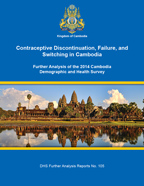- PUBLICATIONS
- JOURNAL ARTICLES
- ACCESS PUBLICATIONS
Publications Summary
- Document Type
- Further Analysis
- Publication Topic(s)
- Family Planning
- Country(s)
- Cambodia
- Survey
- Cambodia DHS, 2014
- Language
- English
- Recommended Citation
- Wang, Wenjuan, and Rathavuth Hong. 2017. Contraceptive Discontinuation, Failure, and Switching in Cambodia. Further Analysis of the 2014 Cambodia Demographic and Health Survey. DHS Further Analysis Reports No. 105. Rockville, Maryland, USA: ICF.
- Download Citation
- RIS format / Text format / Endnote format
- Publication Date
- July 2017
- Publication ID
- FA105
Download
 Contraceptive Discontinuation, Failure, and Switching in Cambodia (PDF, 1113K)
Contraceptive Discontinuation, Failure, and Switching in Cambodia (PDF, 1113K)
Download this publication
There is no printed copy available to order.
